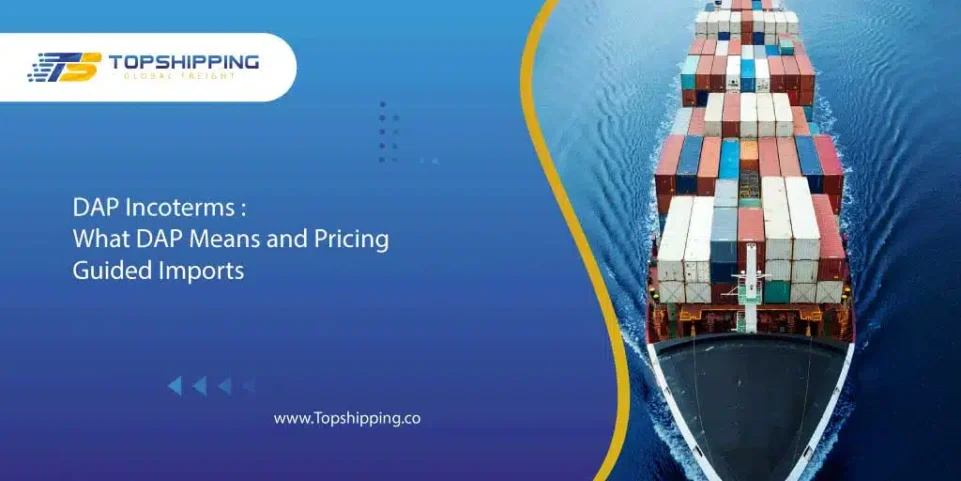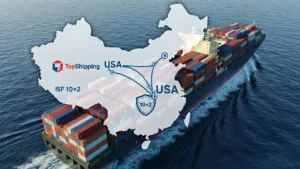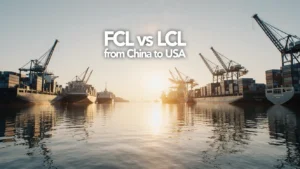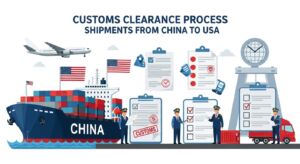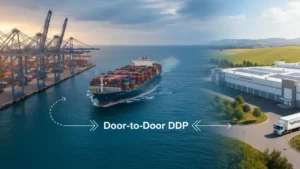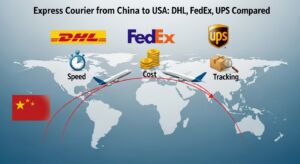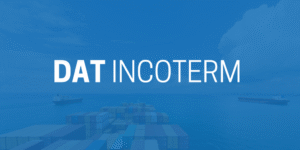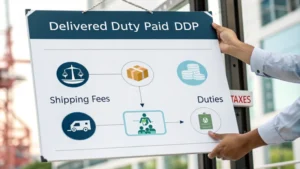Introduction
The DAP Incoterm (Delivered At Place) is one of the most practical and widely used shipping terms under the Incoterms 2020 rules. It defines the responsibilities of both the seller and the buyer in international trade, focusing on the point of delivery and risk transfer. Under DAP, the seller is responsible for delivering the goods to a specified destination, ready for unloading, while the buyer handles import customs and local taxes.
This term offers flexibility for global shipping routes and is often chosen for its balance between convenience and cost efficiency. Understanding DAP shipment terms helps importers and exporters avoid confusion about who pays for transport, insurance, or customs clearance ensuring smoother international transactions.
In this guide, we’ll explore how DAP shipping Incoterms work, the roles of each party, key advantages, and how DAP compares with other trade terms such as DDP and CIP.
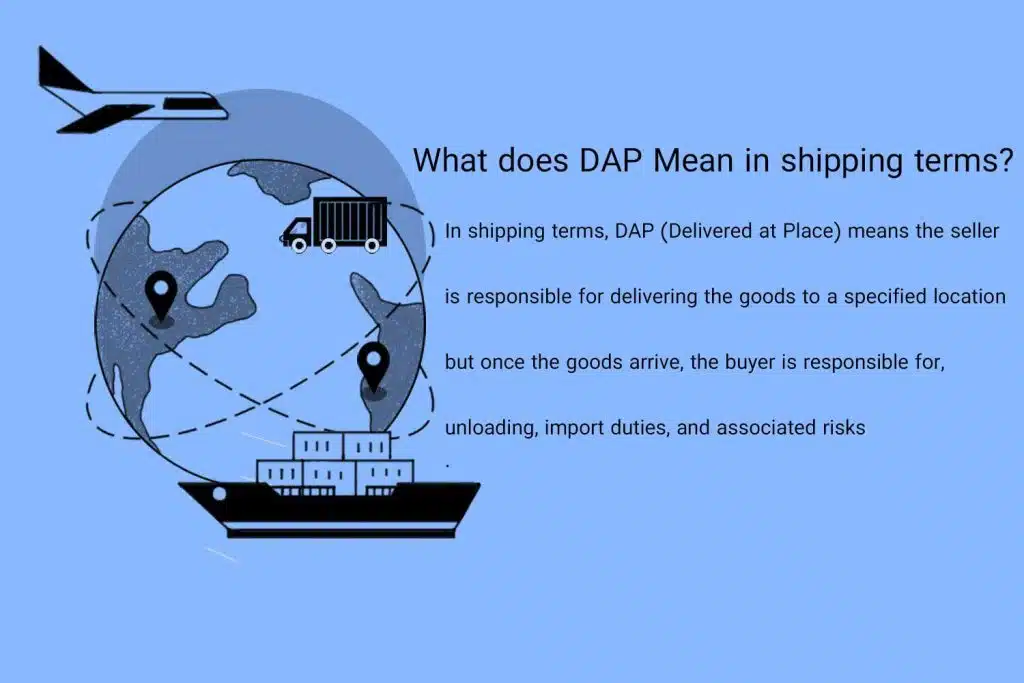
What is DAP? Delivered at Place Meaning
DAP (Delivered at Place) is an international trade term under the Incoterms 2020 rules that defines when and where the seller’s responsibility ends and the buyer’s begins. Under DAP shipping Incoterms, the seller delivers the goods to the agreed destination such as the buyer’s warehouse, port, or terminal ready for unloading.
This means the seller handles all costs and risks involved in transporting the goods to the destination country, including export customs clearance and main carriage. Once the goods arrive at the specified place, the buyer takes over, responsible for unloading, import customs clearance, and paying any duties or local taxes.
DAP Incoterms 2020: Key Updates and Rules
The DAP Incoterms 2020 introduced several updates to clarify the responsibilities and reduce confusion between sellers and buyers during international shipping. While the core meaning of Delivered at Place remains the same, the new version refined transport obligations and risk transfer points to fit modern trade logistics.
Under the DAP 2020 rules, the seller must:
- Deliver goods to the named destination, ready for unloading.
- Bear all transport costs and risks until the goods reach that place.
- Handle export customs clearance and required export documentation.
The buyer, on the other hand, must:
- Take responsibility for unloading the goods.
- Complete import customs clearance.
- Pay any applicable DAP duties, taxes, or local charges.
A key update in DAP shipment terms is the flexibility in transport options now including multimodal transport, combining sea, air, and land freight.
This makes DAP transport terms suitable for complex global supply chains where goods move across multiple carriers and routes.
Overall, DAP Incoterms 2020 reinforce clarity and efficiency in international trade, ensuring that both parties understand their financial and logistical obligations before shipping begins.
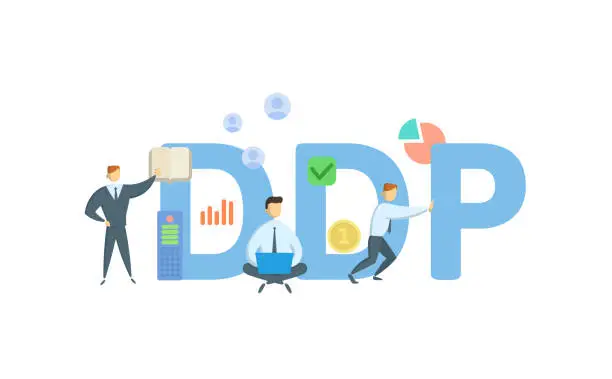
When & Where to Use DAP ?
DAP (Delivered at Place) is best used when the seller can manage the main transportation and export process efficiently, while the buyer prefers to handle import procedures and local taxes. It’s an ideal choice for trade routes where the seller has strong logistics partners or reliable freight forwarders in the destination country.
You should consider using DAP shipment terms when:
- The buyer does not want to arrange international transport or bear early shipping risks.
- The seller has better access to affordable or reliable freight options.
- The goods require multimodal transport (a mix of sea, air, and road freight).
- Import duties and customs regulations in the buyer’s country are best managed by the buyer.
Typical examples include shipping from China to the USA, or freight forwarding between European countries, where sellers deliver goods to an agreed location such as a port terminal, warehouse, or industrial zone and transfer responsibility upon arrival.
In short, DAP Incoterms are most suitable when both parties want a fair balance of responsibility:
the seller manages safe delivery to the buyer’s country, while the buyer controls import clearance and final delivery steps.

Seller’s Responsibilities under DAP
Under DAP shipping Incoterms, the seller carries most of the responsibility throughout the international transport process up to the moment the goods reach the agreed destination. The goal is to ensure that the buyer receives the goods safely and on time, without managing export procedures or main carriage arrangements.
Here’s what the seller must handle under DAP shipment terms:
Export Customs Clearance
The seller must prepare all export documentation and complete customs formalities in the country of origin. This includes invoices, packing lists, export licenses, and any certificates required by authorities.
Freight and Main Transport
The seller is responsible for booking and paying for the transportation whether by sea, air, road, or a combination. This covers the main leg of the journey until the goods reach the destination place.
Risk and Cost Until Delivery
All transport risks and costs remain with the seller until the goods arrive at the named place, ready for unloading. This includes potential damages or delays during transit.
Delivery at Named Place
The seller must ensure the goods are delivered ready for unloading at the buyer’s designated location (port, warehouse, or logistics hub). However, the seller is not responsible for unloading the goods.
No Obligation for Import Duties or Taxes
While the seller handles transportation and export processes, any DAP duties or import taxes are the buyer’s responsibility.
Ithe seller under DAP Incoterms 2020 takes full control of shipping, ensuring a smooth export and safe arrival making DAP ideal when the seller has strong logistics capabilities.
Buyer’s Responsibilities under DAP
Under DAP Incoterms 2020, the buyer’s role begins once the goods arrive at the agreed destination, ready for unloading. Although the seller covers most of the transportation process, the buyer still has key responsibilities related to import, unloading, and final delivery.
Here’s what the buyer must handle under DAP shipment terms:
Unloading the Goods
When the goods reach the named destination, the buyer is responsible for unloading them from the arriving vehicle or container. The seller’s obligation ends when the goods are ready for unloading not after.
Import Customs Clearance
The buyer must take care of all import-related procedures, including customs clearance, documentation, and compliance with local regulations. This ensures the goods can legally enter the destination country.
Payment of Duties, Taxes, and Local Charges
Any DAP duties, import taxes, or additional fees charged by customs or local authorities are fully paid by the buyer. These costs can vary depending on the country and product category.
Final Delivery Arrangements
After unloading and customs clearance, the buyer organizes the final inland transportation from the arrival location (port, terminal, or warehouse) to the final destination if needed.
Insurance for Buyer’s Risk Zone
While insurance during international transport is optional and typically covered by the seller up to the destination, the buyer should consider arranging insurance for the local leg of transport after unloading.
under DAP shipping Incoterms, the buyer takes responsibility once the goods are ready for unloading. Managing import formalities and related costs allows the buyer to maintain control over compliance and delivery in their own country.
DAP Cost and Prices: How Costs Are Calculated
Understanding the cost structure under DAP Incoterms is essential for both sellers and buyers to avoid surprises during international transactions. Since responsibilities are clearly divided, each party knows which costs they are accountable for.
Seller’s Costs under DAP
The seller covers most expenses up to the named delivery place:
- Export Documentation & Customs Fees :Costs for preparing invoices, licenses, and export clearance.
- Transportation Costs : Freight charges for sea, air, or road transport to the agreed destination.
- Handling & Packaging :Proper packaging, loading at the origin, and any handling fees during transit.
- Optional Insurance : While not mandatory under DAP, sellers can choose to insure goods until delivery.
Buyer’s Costs under DAP
The buyer is responsible for costs after the goods arrive at the destination:
- Unloading Fees : Charges for unloading goods from the vehicle or container.
- Import Duties & Taxes : Customs duties, VAT, or other applicable local charges.
- Local Transport : Delivery from the arrival point to the final warehouse or facility.
- Insurance: Optional, but recommended for risks after arrival.
Calculating DAP Prices
To calculate a DAP price, add together:
- Seller’s costs (freight, export, handling, optional insurance)
- Buyer’s anticipated costs (import duties, unloading, local delivery)
This calculation ensures transparency and allows both parties to budget accurately for international trade transactions.
DAP Incoterms offer a clear cost-sharing structure: the seller manages international shipping costs, while the buyer handles local import expenses creating a predictable and balanced trade process.
DAP Duties: Import Taxes, Customs, and Charges
Under DAP Incoterms 2020, import duties, taxes, and customs charges are always the responsibility of the buyer. This clear division helps both sellers and buyers avoid confusion about who pays for what in international trade.
Key Points About DAP Duties:
Import Taxes and VAT
Buyers are responsible for all applicable value-added tax (VAT) or sales tax that may be levied by the destination country. This ensures compliance with local tax regulations.
Customs Clearance Fees
The buyer handles customs formalities, including filing documents, paying tariffs, and any administrative fees charged by customs authorities.
Local Charges and Handling Fees
Any costs incurred during unloading, terminal handling, or local transport after the goods arrive are borne by the buyer.
No Seller Liability After Arrival
Once the goods are delivered to the agreed destination ready for unloading, the seller’s responsibility ends. Any import-related duties or charges are not the seller’s obligation.
Practical Tip
For smooth transactions, buyers should calculate all expected import costs before agreeing on DAP terms.
Knowing the estimated duties, taxes, and local charges in advance helps avoid delays and unexpected expenses at the destination.
In summary, under DAP Incoterms, the seller delivers the goods safely to the named place, while the buyer ensures compliance with import regulations and pays all associated duties and charges creating a clear and fair allocation of responsibilities.

DAP Transport Terms: Shipping Methods and Logistics
Under DAP Incoterms 2020, transport arrangements are primarily the seller’s responsibility, covering the journey from the point of origin to the agreed destination. Choosing the right shipping method and planning logistics carefully ensures that goods arrive safely and on time.
Shipping Methods Under DAP
Multimodal Transport
DAP is highly flexible, allowing multimodal shipping combining sea, air, rail, or road transport depending on cost, speed, and route efficiency. This is especially useful for global trade where goods cross multiple countries and transport modes.
Sea Freight
Common for bulk cargo or containerized shipments, sea freight under DAP ensures the seller manages the vessel booking, port handling, and delivery to the agreed terminal or warehouse.
Air Freight
Faster but more expensive, air Freight is suitable for high-value or time-sensitive goods. Sellers arrange air cargo, customs export clearance, and delivery to the buyer’s airport or terminal.
Road or Rail Transport
For regional or intra-continental shipments, sellers handle truck or rail transport to the named destination, ensuring compliance with transit regulations.
Logistics Responsibilities
- Seller: Manages export documentation, transport bookings, freight charges, and risk until delivery at the named place.
- Buyer: Handles unloading, import customs clearance, local delivery, and post-arrival insurance if needed.
Risk Transfer
Under DAP, risk transfers from seller to buyer at the point when the goods are delivered ready for unloading at the agreed place.
This is a key distinction: the seller bears all risks during transit, while the buyer assumes risk only after arrival.
DAP Incoterms Insurance Responsibility: Who Covers What
Under DAP (Delivered At Place) Incoterms, insurance is not mandatory. Unlike CIF or CIP, where the seller must insure goods, DAP leaves the decision to the parties involved. Understanding who covers insurance at different stages helps prevent disputes and financial losses.
Seller’s Insurance Responsibilities
- The seller is responsible for goods in transit up to the named place of delivery.
- While not required, sellers may choose to insure goods to protect against damage or loss during the main carriage. This is optional and often depends on the contract terms or buyer preference.
Buyer’s Insurance Responsibilities
- Once the goods arrive at the agreed destination ready for unloading, risk transfers to the buyer.
- The buyer is encouraged to arrange insurance for the local leg of transport or during unloading, especially if goods are fragile or high-value.
Key Points to Consider
DAP does not automatically include insurance, so both parties should clarify coverage in the contract.
For high value shipments, having insurance for both international transit (optional seller coverage) and domestic handling (buyer coverage) is recommended.
Clear communication about insurance responsibilities avoids disputes if damage occurs during shipment or unloading.
DAP Shipping Cost Calculator: Estimating Your Expenses
Estimating costs under DAP Incoterms is essential for both sellers and buyers to budget accurately and avoid unexpected charges. A DAP shipping cost calculator helps break down the expenses clearly by separating seller and buyer responsibilities.
Seller-Side Costs
The seller is responsible for most transport related expenses up to the agreed delivery place:
- Export Documentation & Customs Fees : Costs for invoices, licenses, and clearance at origin.
- Freight Charges : Sea, air, or road transport to the destination.
- Handling & Packaging : Proper packing, loading, and any terminal handling fees.
- Optional Insurance : Seller may choose to insure goods during transit.
Buyer-Side Costs
The buyer covers expenses after the goods arrive at the destination:
- Unloading Fees : Charges for unloading goods from the vehicle or container.
- Import Duties & Taxes : Customs duties, VAT, and other local charges.
- Local Transportation : Delivery from the arrival point to the final warehouse or facility.
- Insurance :Optional coverage for the goods after arrival.
Using a DAP Shipping Cost Calculator
A cost calculator can help you:
- Estimate total landed cost by combining seller and buyer expenses.
- Compare DAP with other Incoterms, such as DDP or FOB, to find the most cost-effective solution.
- Plan your budget for duties, taxes, and local transport ahead of time.
Differences Between DAP and Similar Incoterms (DDP, EXW, FOB)
| Incoterm | Seller Responsibility | Buyer Responsibility | Risk Transfer |
|---|---|---|---|
| DAP | Delivery to named place, transport, export clearance | Unloading, import duties, local transport | At arrival ready for unloading |
| DDP | Everything including import duties | Minimal (receiving goods) | At destination |
| EXW | Makes goods available at origin | All transport and customs | At origin premises |
| FOB | Loading onboard vessel | Main carriage and import | Once goods loaded on vessel |
Understanding how DAP compares with other common Incoterms helps businesses choose the best shipping strategy based on cost, responsibility, and risk.
1. DAP vs DDP (Delivered Duty Paid)
- DAP: The seller delivers goods to the named place ready for unloading, but the buyer pays import duties, taxes, and customs charges.
- DDP: The seller is responsible for all costs, including import duties and taxes, delivering the goods fully cleared to the destination.
- Key Difference: DAP shifts import obligations to the buyer, while DDP (Delivered Duty Paid) makes the seller responsible for all delivery costs and customs clearance.
2. DAP vs EXW (Ex Works)
- DAP: The seller manages export clearance and transportation to the buyer’s destination.
- EXW: The seller only makes goods available at their premises, and the buyer handles everything else, including export, freight, and import.
- Key Difference: DAP provides much more convenience to the buyer, while EXW (Ex Works) places almost all responsibility on the buyer.
3. DAP vs FOB (Free on Board)
- DAP: The seller delivers goods to the agreed destination, bearing transport costs and risks until arrival.
- FOB: The seller delivers goods onboard the vessel at the port of shipment, and risk transfers to the buyer once loaded.
- Key Difference: DAP covers main carriage and transport to destination, whereas FOB (Free on Board) stops at the port of shipment.
Advantages & Disadvantages of DAP
Understanding the advantages and disadvantages of DAP Incoterms helps businesses decide whether this shipping term fits their trade needs.
Advantages of DAP
- Clear Division of Responsibilities :The seller handles all transport and export obligations, while the buyer focuses on import procedures, minimizing confusion.
- Flexibility in Transport Modes :DAP supports multimodal shipping, including sea, air, road, or rail, making it suitable for complex international logistics.
- Predictable Costs for the Seller :The seller knows their financial responsibilities upfront, covering transport and export fees up to the agreed destination.
- Reduced Buyer Effort in International Shipping :The buyer does not need to manage international freight or export documentation, simplifying global trade.
Disadvantages of DAP
- Buyer Handles Import Duties and Taxes :The buyer bears all import-related costs, which can sometimes be unpredictable or vary between countries.
- Seller Bears Most Transit Risk :The seller assumes responsibility for damage or loss until the goods arrive at the named destination.
- Limited Control for Buyer During Transport :Buyers cannot influence the choice of carrier or transport route until the goods arrive at their location.
- Optional Insurance Can Be Risky :Since DAP does not require mandatory insurance, either party may face losses if goods are damaged during transit without proper coverage.
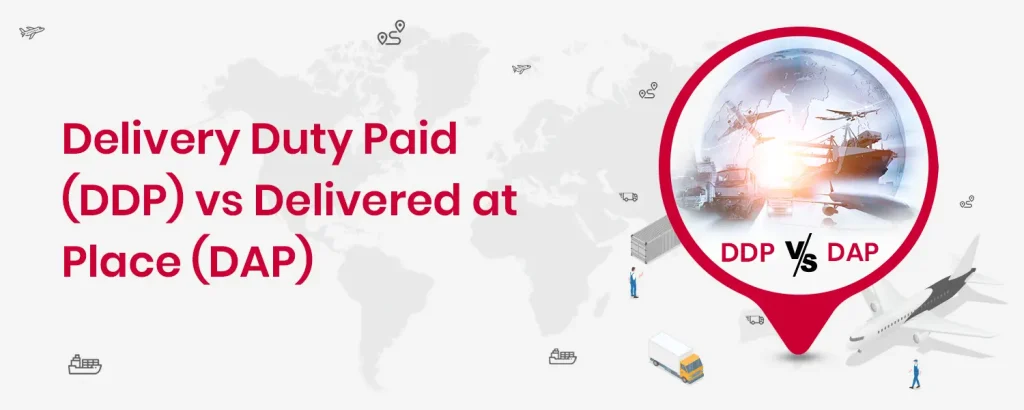
Common Mistakes & Risk Mitigation in DAP Transactions
Even though DAP Incoterms provide clarity in international shipping, mistakes can occur if parties are not careful. Recognizing common pitfalls and applying risk mitigation strategies ensures smoother transactions.
Common Mistakes in DAP Transactions
Misunderstanding the Point of Risk Transfer
Some buyers assume the seller is responsible after delivery, but under DAP, risk transfers when goods are ready for unloading at the agreed destination.
Neglecting Import Duties and Taxes
Buyers may underestimate or forget to account for customs duties, VAT, or local charges, causing delays or extra costs.
Ignoring Unloading Arrangements
Since unloading is the buyer’s responsibility, failing to prepare equipment, manpower, or local permits can lead to delays or fines.
Assuming Mandatory Insurance
DAP does not require insurance, so parties assuming coverage may face financial loss if goods are damaged during transit.
Incomplete Documentation
Sellers sometimes overlook export documents or certificates, while buyers may not prepare for import paperwork, leading to customs clearance problems.
Risk Mitigation Strategies
Clearly Define Responsibilities in Contracts
Explicitly mention who handles transport, duties, taxes, unloading, and insurance to avoid disputes.
Budget for Import Costs
Buyers should calculate estimated duties, taxes, and local fees before agreeing to DAP terms.
Plan Unloading in Advance
Buyers must ensure the arrival location is ready, with proper equipment, manpower, and permits for smooth unloading.
Consider Insurance Options
Sellers may insure goods during transit, and buyers should consider coverage for post-arrival handling and local transport.
Ensure Complete Documentation
Both parties should verify that export and import paperwork is accurate and compliant with local regulations.
Practical Example / Scenario (with Numbers)
Let’s consider a practical scenario of shipping electronics from China to the USA under DAP terms.
Scenario Details
- Seller: Electronics manufacturer in Shenzhen, China
- Buyer: Electronics retailer in New York, USA
- Goods: 1,000 units of laptops
- Unit Price: $500
- Transport Method: Sea freight
- Destination: Buyer’s warehouse in New York
Step 1: Seller Costs
| Item | Cost (USD) | Notes |
|---|---|---|
| Export documentation & customs clearance | 200 | Invoice, packing list, export license |
| Sea freight to New York port | 1,500 | Main carriage cost |
| Packaging & handling | 300 | Crates, loading, terminal handling |
| Optional insurance | 500 | Protect goods during transit |
Total Seller Cost: $2,500
Step 2: Buyer Costs
| Item | Cost (USD) | Notes |
|---|---|---|
| Export documentation & customs clearance | 200 | Invoice, packing list, export license |
| Sea freight to New York port | 1,500 | Main carriage cost |
| Packaging & handling | 300 | Crates, loading, terminal handling |
| Optional insurance | 500 | Protect goods during transit |
Step 3: Key Points
- Seller Responsibility: Up to delivery at the warehouse, including export, freight, and handling.
- Buyer Responsibility: Unloading, import duties, local transport, and optional insurance after arrival.
- Risk Transfer: Occurs when goods arrive ready for unloading at the buyer’s warehouse.
Step 4: Total Cost of Transaction
- Seller: $2,500
- Buyer: $50,900
- Combined Total: $53,400
This example illustrates how DAP terms clearly separate responsibilities and costs, allowing both parties to plan budgets accurately and reduce disputes.
Checklist & Best Practices for DAP Transactions
Using DAP Incoterms effectively requires careful planning and attention to responsibilities. Here’s a practical checklist and best practices for both sellers and buyers:
Seller Checklist & Best Practices
Confirm the Agreed Destination
Ensure the delivery address is clear, accessible, and capable of handling the shipment.
Prepare Export Documentation
Include invoices, packing lists, export licenses, certificates, and any required customs forms.
Choose Reliable Transport
Select freight forwarders or carriers with proven track records to minimize delays and damages.
Manage Costs Accurately
Calculate export, transport, and optional insurance costs upfront to avoid unexpected expenses.
Consider Optional Insurance
Even though DAP doesn’t mandate it, insuring goods during transit reduces financial risk.
Buyer Checklist & Best Practices
Understand Import Duties and Taxes
Calculate all import fees, VAT, and customs charges in advance.
Prepare for Unloading
Ensure manpower, equipment, and permits are ready at the arrival location.
Arrange Local Transport
Plan delivery from the arrival point to the final destination efficiently.
Consider Post-Arrival Insurance
Protect goods during unloading and domestic transport.
Verify Documentation
Review all paperwork provided by the seller and ensure compliance with local regulations.
Final Review
In brief, DAP is one of the most important Shipping Incoterm in international trade since it outlines the responsibility both for a buyer and a seller with regard to goods being delivered.
According to conditions under DAP Shipping Incoterms, a seller is obliged to deliver goods to a destination indicated by a buyer at his own expense and risk related to transportation and export clearance.
If goods have already arrived at a place specified in the contract, then buyers take over all responsibilities for further logistics: import duties and clearance.
Shipping Incoterms such as DAP do have their merits, which include minimum risk for the buyer and no hassle in shipping arrangements. Yet, there lies a chance of delay and extra cost on this account.
Besides, effective communication and an agreed division of responsibilities will ensure any transaction based on the DAP terms proves successful.
FAQs : DAP Incoterms
What does it mean DAP Incoterms?
DAP (Delivered at Place) means the seller delivers goods to a named place in the buyer’s country, covering all transport costs and risks until that point.
Who pays for DAP shipping?
The seller pays for all shipping and transportation costs until delivery at the agreed destination.
Who pays duty in DAP Incoterm?
The buyer is responsible for paying import duties, taxes, and customs clearance fees.
What are the duties of DAP?
The seller handles export procedures, transport, and delivery; the buyer manages import clearance, duties, and unloading.
Who clears customs under DAP?
The buyer clears customs and pays all related import charges.
Who pays insurance in DAP Incoterms?
Insurance is optional, but if taken, it’s usually arranged and paid by the seller for their own risk.
What are the rules for DAP Incoterm?
Under DAP, the seller bears all risks and costs until goods reach the agreed location, but not import clearance or duties.
How is DAP different from DDP?
In DAP, the buyer pays import duties and taxes; in DDP, the seller pays them.
When should you use DDP shipping?
Use DDP when the seller wants to offer door-to-door delivery with minimal buyer involvement in customs.
Why should DDP be avoided?
DDP can be risky for sellers due to complex foreign customs, unpredictable taxes, and higher total costs.
Is DDP cheaper than DAP?
No, DDP is usually more expensive because it includes import duties, taxes, and full delivery costs.
Is DDP the same as FOB destination?
No, DDP and FOB destination differ; DDP applies internationally under Incoterms, while FOB destination is a domestic shipping term.
